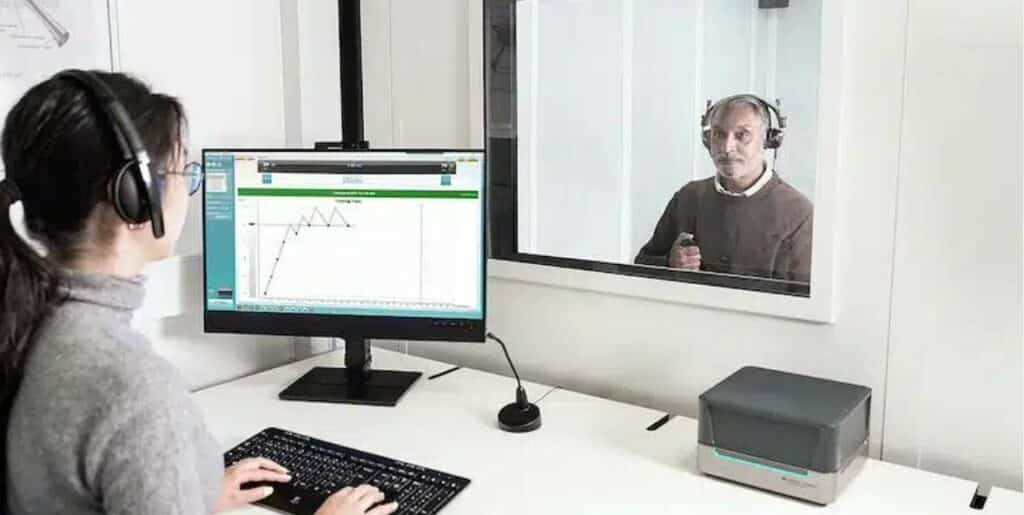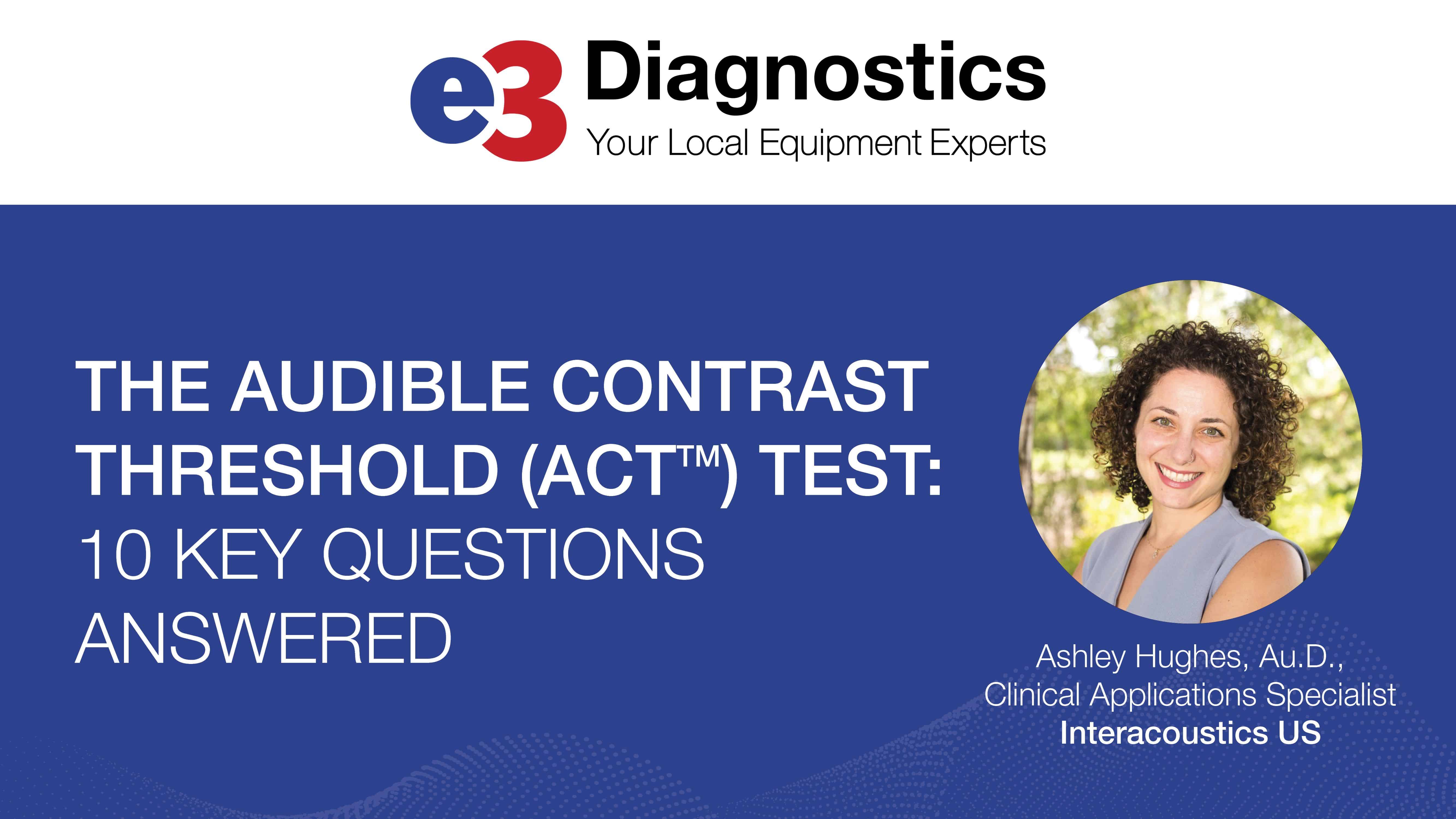This article explores the new Audible Contrast Threshold Test (ACT™) through a series of 10 questions answered by Ashley Hughes, Au.D., Clinical Applications Specialist at Interacoustics. Discover what ACT™ is and learn how to seamlessly integrate it into your clinical practice.
1. Could you provide a brief explanation of the Audible Contrast Threshold Test (ACT™)?
Hughes: ACT™ is a nonlinguistic test, meaning it doesn’t involve languages. Its results provide insights into a patient’s performance in noisy environments with hearing aids. The test follows the Hughson Westlake procedure, using the ascending method for audiometric threshold finding.
In ACT™, the objective is to identify the contrast threshold between two stimuli: the base stimulus (pink noise) and a modified version with spectro-temporal modulation, creating a siren-like sound.
Spectro-temporal modulation involves changes in both the frequency (spectral) and amplitude (temporal) aspects of a stimulus over time. The test aims to pinpoint the threshold at which the patient can detect the spectro-temporal modulation (siren) over the baseline pink noise.
2. Can you briefly explain how ACT™ was developed?
Hughes: ACT™ has undergone more than 7 years of development involving various groups such as the Interacoustics Research Unit (IRU), Interacoustics, Eriksholm Research Centre, and the Centre for Applied Audiology Research (CAAR). The research encompassed various phases, primarily focusing on understanding spectro-temporal modulation and its correlations with speech and noise.
After learning from the research, ACT™ was developed as a user-friendly test that uses existing equipment, is easy to execute, and takes on average only 2 minutes to perform.
3. Could you provide a summary of the procedure for conducting ACT™, including the testing protocol and what hearing care professionals can anticipate doing?
Hughes: First, you need to have an audiogram done or already in your system because the ACT™ presentation level is based on the patient’s audiometric thresholds.
ACT™ presents the stimuli at supra threshold levels, ensuring that all sounds presented are within the patient’s audible range, giving us accurate results.
Let’s work through an example using the Interacoustics Affinity Suite. After performing the audiogram, you’d go to Menu –> Tests and select ACT™. The starting presentation level is pre-determined by the software (based on the patient’s audiogram).
Then, you instruct your patient by saying, “You will hear two sounds. One sounds like noise and the other like a siren. When you hear the siren, press the button, even if it’s very quiet.”
Now, you begin presenting the sounds and do your bracketing according to the traditional modified Hughson Westlake procedure. The test stops automatically after you get three out of five responses in the ascending trial. The ACT™ value is then given.

4. Can you offer any tips to clinicians who are performing ACT™ for the first time?
Hughes: I suggest that those conducting the test try it on themselves or have someone else do it for them. This way, you can truly grasp how the modulation sounds, especially in those bands of pink noise.
5. What are the advantages of ACT™ for clinicians and their clients?
Hughes: The result you obtain from the ACT™ test is called the normalized Contrast Level or nCL. Once the ACT™ test is completed, the nCL value, ranging from -4 to 16, is determined. With this ACT™ value, you can decide how to program advanced features on hearing aids to optimize the patient’s performance.
A higher ACT™ value indicates a poorer prediction of aided performance in noise. Like a QuickSIN or dB value in an audiogram, a lower number is better. This information is valuable for both the patient and the clinician.
The ACT™ value provides objective guidance on setting up advanced features during fitting, potentially leading to improved outcomes and better performance in noise from the patient’s perspective. This can result in reduced follow-up visits, benefiting both sides by minimizing the need for extensive fine-tuning and helping patients get the most out of their hearing aids.
For example, if you take two people that have the same hearing loss but different ACT™ values, adjustments can be made to the hearing aids to suit individual needs. A low ACT™ value suggests that advanced features may not be needed as much, allowing the brain to naturally process sounds. On the other hand, a high ACT™ value indicates a greater need for features like directionality to excel in noisy environments.
6. Does ACT™ use descriptive language like QuickSIN, or is it just a numerical score without a sentence – like translation, such as – 4 meaning normal?
Hughes: So yes, the ACT™ value (dB nCL) is described in words as the prediction for aided speech in noise performance, and severity levels are used. An ACT™ value of – 4 to 4 nCL is normal, 4 to 7 nCL is mild, 7 to 10 nCL is moderate, and 10 to 16 nCL is severe.
Based on severity level, fitting advice is given. For example, if someone has a severity level of moderate, the fitting advice is to set adaptive features slightly lower than maximum level.
7. Based on your expertise, how would you integrate ACT™ into your existing test process? Can you share your thoughts on when and where ACT™ fits best?
Hughes: I would start with otoscopy, then move on to impedance, and conduct pure tone air conduction testing. Once the air conduction thresholds are determined, I’d proceed with ACT™. The reason for this order is that the ACT™ instructions for the patient are like those for pure tone audiometry and use the same transducers. Following ACT™, I’d continue with speech testing.
8. Do you think incorporating ACT™ could help differentiate your clinic in the OTC landscape?
Hughes: That’s an excellent question, and I hadn’t considered it before, but I genuinely believe it can! For instance, if someone comes to your clinic with over the counter (OTC) hearing aids, and you recommend a hearing test, you may discover that OTC devices aren’t adequately addressing their specific hearing loss. By adding ACT™, a quick two-minute test, if you observe significant difficulties in noise, you gain valuable insights into why OTC solutions may not be suitable. This information suggests they might need a more adaptable or customizable solution for better success.
9. Why do you think performing speech in noise testing, such as ACT™, is important?
Hughes: We know that patients typically don’t approach us with instances like, “I had trouble hearing a quiet beep in the library last week.” Instead, their concerns revolve around real-life scenarios like struggling to hear grandchildren, navigating conversations in restaurants, or enjoying activities such as golf while facing communication challenges.
ACT™ uniquely targets these specific concerns, providing valuable insights aligned with the patient’s experiences. Incorporating ACT™ into your testing protocol can significantly distinguish your practice, with patients often expressing surprise that it’s the first time they’ve undergone such an assessment.
Also, the test results often initiate meaningful counseling discussions as patients gain a clearer understanding of the extent of their hearing difficulties.
10. How can clinicians’ access ACT™?
Hughes: Clinicians can reach out to their e3 Diagnostic Sales Representatives to learn more.
Currently, ACT™ is available for Interacoustics Affinity Compact, Grason-Stadler AudioStar Pro, and MedRx AVANT ARC, AVANT A2D+, AWRC, and AVANT (Stealth)
Ashley Hughes, Au.D. Clinical Applications Specialist at Interacoustics US is the main point of contact for audiometry, impedance, otoacoustic emission, hearing aid fitting, and telehealth solutions. Prior to joining Interacoustics, Dr. Hughes worked clinically and then as a research audiologist. She has served as an invited speaker at state and national conferences and is an author on multiple published articles and posters on topics including real-ear measurements, subjective outcome measures, advocacy, mentorship, negotiations, and more. She is highly involved in the American Academy of Audiology along with her state audiology organization, the Minnesota Academy of Audiology.






